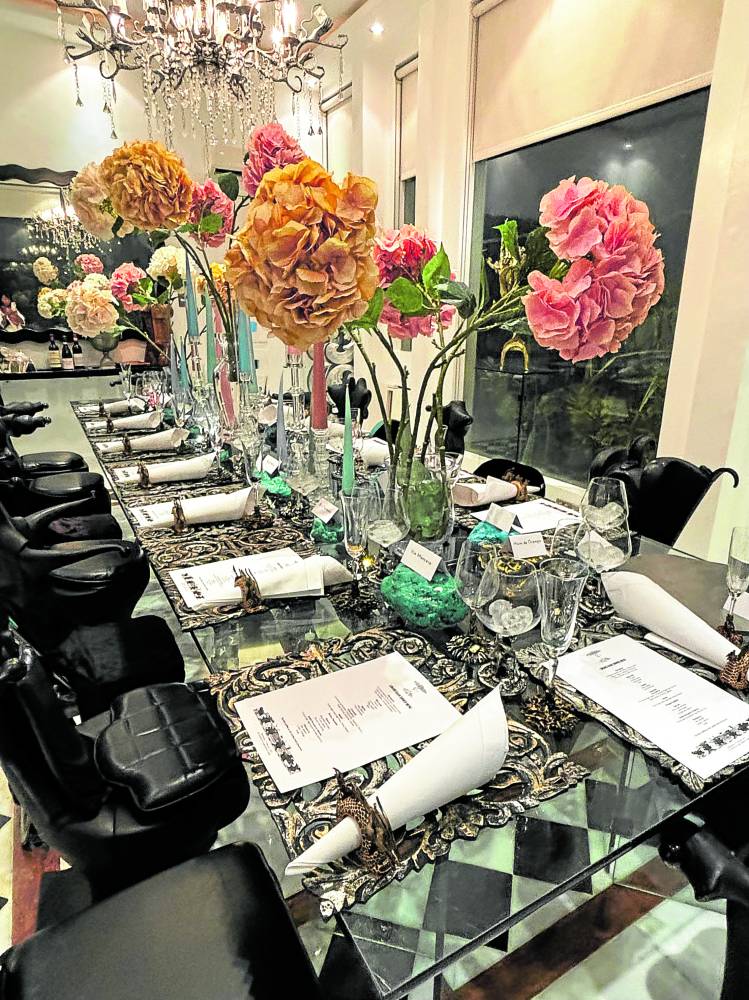Living up to her reputation as the “hostess with the mostest,” Kathleen “Maymay” Liechtenstein has a treasure trove of partyware—32,000 pieces as of July 2023, and still counting. She is known for her far-reaching travels to source ingredients and accessories, commissions with artists for her tableware and an eye-catching hostess wardrobe to match.
Whenever this Ballet Philippines (BP) president hosts a meal at her party home in Muntinlupa, the menu is usually based on the forthcoming production. The dinner announced BP’s season-ender “Limang Daan,” a full-length contemporary ballet about five Filipinas in different eras transcending social and gender barriers. It will premiere on March 8 at Theater at Solaire. In attendance were Mikhail Martynyuk, BP’s artistic director and choreographer, librettist Moira Lang and composer Erwin Romulo. In keeping with the nationalistic theme, the hostess created a “quasi-heritage dinner,” inspired by her trip to Bacolod and the Negros Slow Food Movement, but infused with imported ingredients.
The table setting played on exaggerated proportions. The 16-seater table was lined with big silk flowers. “Somebody gave me 42 pieces for my birthday last January,” she said. The flowers alternated with tall candles from Paris. Name cards were placed on turquoise stones sourced from Nepal and natural stones from Zhuji, China. The wooden chargers—carved with baroque patterns and finished with metallic silver and gold leaf—made a strong decorative impact.
READ: Maymay Liechtenstein designs ‘multi-sensorial’ dinner for Ballet Philippines
Referencing the Lunar New Year zodiac, the napkin ring was a carved dragon. Both the carved charger and the napkin ring came from Bergdorf Goodman, one of Liechtenstein’s go-to places. She favors linen napkins from Switzerland for their luxurious texture and body when starched.
Commissioned in Milan
Commissioned tableware makes her entertainment very unique. She commissioned a glass artist in Milan to make 32 square ceramic plates (with “Liechtenstein” on the lower corner). While visiting Portland, Oregon, she met an artisan who created ceramic figurines for votives. She used the votives to hold mini popsicles in different fruit flavors as a palate cleanser.

In Baguio, she asked an artisan, who made filigree silver jewelry, to create her teapot and cups. A collector of the works of the late sculptor Gabriel Barredo, she asked him to create metal trees that hold food, mother-of-pearl plates, carved dining utensils and metal faces and curlicued bases for the crystal stemware.
“When you eat, you also want to give pleasure to the eyes,” said Liechtenstein.
The abregana, the Visayan word for appetizer, consisted of bite-sized portions of exotic local delicacies paired with foreign foods. The ginamos was made from krill or fermented shrimp, offset by Amadei chocolate, Italian chocolate made from the rarest African cacao, which she bought at the chocolate alley in Pisa. Composta di Amarene (black cherry vinaigrette) substituted for the vinegar for the bagnet chips. The sharpness and creaminess of the Roquefort and pepper jelly were a foil to the crunchy chicharon manok. Their portions looked like specks of color and texture on the customized ceramic plates which, she said, were hand-carried from Europe.
Perched on Barredo’s metal trees, the bola-bolas were made of wafers filled with lumpiang ubod, salted egg and tiny cucumbers. The molo dumpling was dipped in the soup liquid that was spread out on the butterfly plate from Portugal.
The cold fruit soup was made of paho mango, olive oil from Israel, tultul (a rare artisanal salt found in Guimaras, Iloilo) and Kampot pepper, a gift from Cambodian royalty.
“You just put the peppercorn in your mouth, and it blooms on the palate,” she said.
Fruit popsicles
The soup was served in a glass cup atop a mother-of-pearl plate with a golden face. The salad was a merry mix of local fruits and vegetables, atop a dressing of labneh, fermented yogurt from Negros. Little floral trees towered over the salad plate.
A crescent comb with a metal face by Barredo bordered the adobo plate. Liechtenstein maintained that the Filipino meal was incomplete without adobo. Instead of rice and chicken and pork, she used quail and squid eaten with homemade string hoppers, thin noodles made with glutinous rice flour.
The palate was cleansed with a popsicle of various tropical fruits served on a ceramic votive.
Liechtenstein resorted to imported crab and lobster for the sud-an, the Bisayan word for main viand, since the local catch was small. They were placed on top of barnacles, sourced from an island in Palawan. The meal ended with homemade ube spiked with Kampot and a “Zen garden.” On a carved wooden tray, lanson fadridga, a puto made from cassava, Pregando chocolate, ube jam and salab coconut pancake symbolized the stones, while the coco sugar base represented the sand. “If you rake it, you could make designs on the ‘sand,’” said Liechtenstein.
She told Lifestyle of how she would go to remote places around the world to search for heritage foods and how she was accosted by immigration officers in Chile when she carried crillio cacao, the world’s rarest beans. On her phone, she installed an app that holds a catalog of her table accoutrements.
More than being her own party planner, she plays her hostess role to the hilt with her organized meals and cheerfulness. —Contributed INQ